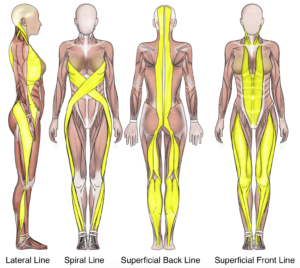Fascia: What does it have to do with my pain?

Fascia forms the largest system in the body as it is the system which touches all other systems
James L. Oschman, PhD
Fascia is a very thin strong connective tissue. It surrounds and intertwines with every muscle, organ, and bone in your body. Some think our skeletal system is what keeps our body upright. What most don’t know is that without our fascial system we would be a puddle on the floor.
There is much new research and information coming out on Fascia. It is starting to get the attention and credit it deserves. For one, it allows our muscles, joints, and organs to glide smooth and friction free over one another. And two, how detrimental it can be when it becomes dehydrated, stiff, and restricted.
Fascia is complicated, so we will keep it simple here. It consists of different types of cells that are very specialized, unlike any others in the body. These cells are all swimming in a fluid called Extracellular Matrix that is mostly made up of collagen and water. Together they make up arguably the most important connective tissue in the body. It has the ability to conduct electricity to signal messages between groups of cells, it can be a fluid yet solid entity almost at the same time, and it can reform itself to any posture you regularly hold (how do you feel about all the sitting you do in a day?).
There are different depths to fascial layers, from right under our skin helping to create a protective barrier from the outside world, to deep in our torso where it keeps all of our organs safely in place. When looking at the body as a whole, we find that the aches and pains you feel, and the restrictions in your range of motion, can come from an area far from the discomfort or disfunction. It could actually be coming from somewhere much more global. It would seem totally unrelated. But there are close relationships between even the neck and ankle when you look on a Fascial level.
The job of a Bowen Therapist is to find where the fascial restrictions are, whether it’s in one area or multiple, and release them. And if they come back, determine why. For instance, work related stress injuries can normally be easily released. But if you go back to the same behavioral patterns, they will most certainly rear their ugly heads again. What can be done to help change the behavior?
When we release a Fascial restriction, but the release does not hold over time, it may be due to the tightness and restrictions of other muscles/fascia in a different part of the body (i.e., knee or foot pain caused by a misaligned pelvis). Where are other restrictions hiding?
When there are multiple restrictions, we need to find out what the primary disfunction is and what are the compensations. At times this is easy and to the point. But you can start to see that over time, people who have restriction on top of restriction, and compensation on top of compensation become a complex case. These are the imbalances that can lead the body into a vulnerable state where illness, injury, and anxiety are more likely to occur.
As a side note. The compensations made by the body have two primary goals that we can see on as physical level. To our Nervous System these two things are crucial; our survival may depend on it. The first is that we will always try to have both feet touching the earth. This is essential to help us sense the surrounding terrain and how to react appropriately to keep our balance. The Second is to conform any way possible so that our eyes are level with the horizon. This is of course to see what’s ahead and be prepared with the appropriate action to deal with it. The next time you’re out, look around and you will see what I’m talking about. No matter what the rest of a body looks like from the head down, the eyes are always level with the horizon.
Fascia is complex and multidimensional. If you want to learn more, a great place to start is the following book, “Fascia: What it is and Why it Matters” by David Lesondak. Easily found on Amazon or other online bookstores.
Fascia and Chronic Pain


